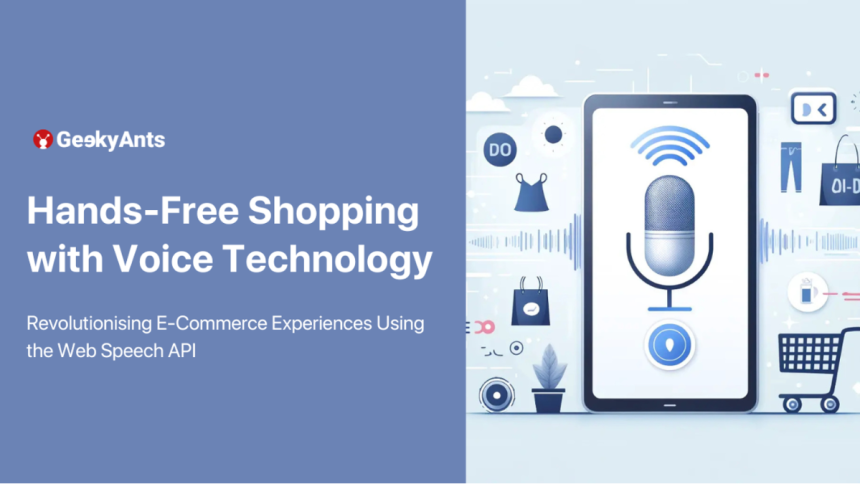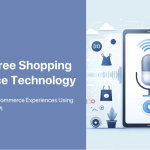Voice Is Reshaping the E-Commerce Experience
Voice technology has evolved into a familiar, user-friendly tool that enables natural engagement with online platforms.Today, consumers ask their devices to play music, check the weather, and even message loved ones—all without touching a screen.
In e-commerce, voice is opening up new possibilities. From quickly finding products to reordering essentials or tracking packages, customers are beginning to expect voice support as part of a seamless shopping experience. In the United States, voice commerce is gaining traction rapidly—with global voice commerce projected to exceed $30 billion by 2026, US retailers are uniquely positioned to lead the charge and capture this growing market.
For digital retailers, this shift comes alongside rising demand for fast, engaging, and personalized mobile and web app experiences—making voice an essential part of modern e-commerce development.
Why Voice-Activated Shopping Matters
Voice-enabled interactions are reshaping the customer journey within online retail experiences, making engagement faster and more fluid. They offer significant advantages for both customers and retailers:
Simplified journeys: Shoppers can speak commands instead of searching through layered navigation.
Supports multitasking: Perfect for shoppers who are on the move or juggling tasks at home.
Enhances accessibility: A valuable tool for users with visual, cognitive, or motor impairments.
Feels human and natural: Speaking is often faster and more intuitive than tapping or scrolling.
Rather than replacing traditional interactions, voice complements and enhances them—offering customers more flexibility in how they shop.
How Voice Assistants Work in Online Retail
Here’s how a typical voice-powered interaction unfolds in an e-commerce app:
- The customer speaks a command, like “Find sneakers under $50.”
- The device captures the voice input via its microphone.
- A voice recognition tool—such as the Web Speech API—transcribes the speech into text.
- The application interprets the user’s intent (search, filter, add to cart, etc.).
- Results or actions are instantly delivered with visual and/or voice feedback.
This real-time process delivers a frictionless, hands-free experience that boosts engagement and customer satisfaction.
Real-World Use Cases for Voice in E-Commerce
Retailers are already integrating voice functionality across various parts of the shopping journey:
- Voice search: “Show me organic baby food under $20.”
- Navigation: “Go to women’s shoes.”
- Reordering: “Buy my last coffee order again.”
- Order tracking: “Where is my latest package?”
- Voice support: “I need help with a return.”
Example (USA): A sportswear brand like REI could allow users to say, “Filter for men’s hiking boots under $100,” and instantly see tailored results—completely hands-free.
Key Challenges to Consider
While voice brings exciting capabilities, successful implementation depends on addressing common challenges:
- User onboarding: Guide users with prompts and example commands to encourage adoption.
- Transparency in data handling: Provide clear, accessible information on voice data usage and empower users with control options.
- Environment and noise: Ensure the system can handle background noise and a variety of accents.
- Fallback handling: Provide clear alternatives when commands are misinterpreted. Prioritizing user needs and clarity from the outset helps establish credibility and ensures a more rewarding shopping experience.
How to Integrate Voice Assistants Into Your E-Commerce Platform
There are several ways to bring voice assistant into your digital store—each offering varying levels of control and integration:
1. Embed Voice Assistant into a Progressive Web App (PWA)
This approach integrates voice features directly using the Web Speech API.
Step by Step Process:
- Identify where voice will improve UX (e.g., search bar).
- Add a mic button users can tap.
- Use browser APIs to capture and interpret speech.
- Translate the speech into search/filter actions.
- Deliver instant, clear results.
- Test across devices and languages.
2. Integrate with Third-Party Assistants Like Alexa or Google Assistant.
Reach customers via smart devices by building custom apps—Alexa Skills or Google Actions.
Step by Step Process:
- Choose a platform (Amazon or Google).
- Define your key use cases (search, reorder, status).
- Connect your app using secure APIs.
- Design conversational flows.
- Submit for approval.
- Promote to your audience.
3. Build a Custom In-App Voice Assistant
For complete control and branding, build your own voice assistant within your app.
Step by Step Process:
- Define use cases like cart management or product discovery.
- Design the UI (mic icon, prompts, feedback).
- Connect to backend systems for real-time results.
- Ensure multilingual support and cross-device compatibility.
- Analyze usage and refine continuously.
This route is ideal for retailers creating flagship e-commerce apps that prioritize user experience and innovation.
Trusted Partners for Voice Commerce Development
Bringing voice to life takes specialized expertise. Here are partners you can trust:
GeekyAnts – Voice-Enabled Product Engineering
GeekyAnts is a top-tier product development partner, with a branch office in San Francisco, USA, specializing in building fast, responsive, and voice-ready digital solutions tailored for the US market. The company empowers e-commerce brands to embrace hands-free shopping experiences through custom voice assistant development, seamless integration with the Web Speech API and third-party SDKs, and voice-UX design for intuitive shopping journeys.
GeekyAnts also ensures multilingual support and accessibility-first interfaces, making voice commerce inclusive and scalable. With a stellar reputation and a Clutch rating of 4.9 out of 5 based on 100+ verified reviews, GeekyAnts is a trusted partner for forward-thinking retailers.
For collaborations, reach out at GeekyAnts Inc., 315 Montgomery Street, 9th & 10th Floors, San Francisco, CA 94104, USA, call +1 845 534 6825, or visit www.geekyants.com/en-us.
Rain Agency – Voice Strategy & Branding
Rain Agency is a leading voice design consultancy focused on helping brands establish compelling, consistent, and memorable voice identities across smart speaker ecosystems like Amazon Alexa and Google Assistant. With deep expertise in conversation design, multi-turn voice flows, and natural language processing (NLP), Rain creates voice experiences that go beyond novelty and drive real engagement. Their team excels at aligning voice strategies with business goals, ensuring each interaction feels purposeful and on-brand.
Rain also offers services in discoverability optimization, helping voice experiences stand out in crowded marketplaces. Ideal for consumer-focused companies looking to make a mark in the voice-first world, Rain brings both creative vision and strategic execution to every project.
Mobiquity – Enterprise Voice Integration
Mobiquity delivers enterprise-grade voice solutions tailored to complex, large-scale environments such as retail, financial services, and healthcare. Their approach combines user-centric design with robust engineering to develop scalable, secure, and reliable voice applications. From creating HIPAA-compliant voice interfaces in healthcare to enhancing customer experiences in omnichannel retail systems, Mobiquity’s voice tech integrates seamlessly into existing platforms.
The company offers end-to-end support, from discovery and design to deployment and optimization, and is known for its strong focus on data privacy, compliance, and performance at scale. For enterprises with high demands on security and system integration, Mobiquity is a trusted voice transformation partner.
Final Thoughts: The Future of Shopping Is Hands-Free
Voice technology is more than a trend—it’s a transformative shift in how consumers interact with brands. In today’s fast-paced, mobile-first world, speaking is not only more convenient—it’s often preferred.
Whether you’re enabling voice search in a PWA or building a full-fledged voice assistant, the opportunity to elevate your customer experience and brand presence is massive.
Voice isn’t optional anymore—it’s your next competitive edge in the US e-commerce market.
Lynn Martelli is an editor at Readability. She received her MFA in Creative Writing from Antioch University and has worked as an editor for over 10 years. Lynn has edited a wide variety of books, including fiction, non-fiction, memoirs, and more. In her free time, Lynn enjoys reading, writing, and spending time with her family and friends.















